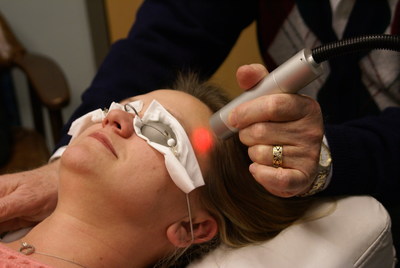How many decades will it take before your doctors run the exact same research on stroke survivors? Or never?
New Study Discovers Near-Infrared Light Therapy (NILT) Effectively Treats Traumatic Brain Injury (TBI) Patients
Co-author Dr. Theodore Henderson hails remarkable findings a
"medical breakthrough," demonstrating the possibility of reversing brain
damage with high-powered infrared light
Aug 21, 2015, 11:52 ET
from Neuro-Laser Foundation
A new study published today in the journal, Neuropsychiatric Disease and Treatment, is being hailed as a "medical breakthrough" in the treatment of traumatic brain injury (TBI), which plagues millions of athletes, military veterans and first-responder professionals.
The study, "Treatments for traumatic brain injury with emphasis on transcranial near-infrared laser phototherapy,"
found that a specific high-powered, near infrared light (NIR) can
effectively re-energize damaged brain cells after penetrating the skin
and skull. All the patients in the study reported significant clinical
improvement in their condition with no negative side effects, according
to Theodore Henderson, MD, PhD, who co-authored the study along with Dr. Larry Morries, and Paolo Cassano
of Massachusetts General. This is the second largest study of NIR for
brain injury and the only one using the more powerful Class-IV laser to
deliver NIR, Dr. Henderson said.
"This is a real game changer," said Dr. Henderson, co-founder of the Neuro-Laser Foundation,
"because these patients have retained the benefits for up to four years
now. For those who have been told there is no treatment for TBI, we
invite you to look closely at what we've found and you will regain
hope."
The Centers for Disease
Control report over 2.5 million emergency visits for concussions and TBI
annually, said Dr. Henderson. Athletes with multiple sub-concussive
blows and military veterans with TBI (over 307,000) also have lasting
symptoms. These symptoms can include headaches, speech irregularities,
confusion, memory slips, lack of impulse control, sleep disturbance,
anxiety, depression, and for some, suicide.
"Patients from the study
experienced a significant reduction of their depressive symptoms as
demonstrated using standardized depression scales," Dr. Henderson said.
"They all improved dramatically. Headaches, depression, anxiety,
insomnia, irritability, mood swings, sleep problems, and relationship
problems all resolved. Several unemployed patients returned to work or
started new careers."
The study occurred from
2011-2013 with 10 people diagnosed with chronic mild-to-moderate TBI as a
result of involvement in athletics, military activities or as
first-responders. The treatments included 10 transcranial applications
of high-power NIR over the course of two months. Using a Class IV laser
and pulsed light, each treatment took less than 60 minutes. Previous
studies with low-powered NIR had shown on transient benefits. In this
study, Morries and colleagues report benefits lasting for years after
treatment.
The exciting news is that
NIR light, in the 10-15W range at 810 nm and 980 nm, can safely and
effectively treat chronic symptoms of TBI, Dr. Henderson said. However,
he cautions that low-powered NIR or diode-based infrared light does not
even penetrate the skin, so not every type of NIR treatment would be as
effective as what Dr. Morries and colleagues have published here.
"We have seen the
effectiveness of NILT transform people's lives. Now, we plan on making
this treatment more widely available," said Dr. Henderson.

Truly exciting news.
ReplyDelete